Of Roe, Rights, and Reconciliation
On the British Columbia coast, the Heiltsuk First Nation asserts its rights to manage its resources, and who has access to them, through the seasonal herring harvest.
Article body copy
This article is one in a three-part series that explores reconciliation with Canada’s Indigenous people through reinvigorating control and access to resources. The others are “In the Kingdom of the Bears” and “Deer Wars: The Forest Awakens.”
The waters of Spiller Channel are dark cobalt blue, the sea’s surface chopped by a wind that knifes out of the north. The sky is a gray blanket from which snowflakes shake loose over our skiff as it speeds toward a point just shy of Tate Lagoon.
Paradoxically, the snow signals a warming trend along the central coast of British Columbia, the first hint of spring. The previous day, the last of March, had been what airplane pilots refer to as “severe clear”—bright blue sky, with lips and fingertips to match.
“Yesterday was so cold,” says Úmx̌λaqs Louisa Housty-Jones, a Haíłzaqv (Heiltsuk) First Nation project manager, and, at this time of the year, a devotedly single-minded harvester of one of the great prizes on Canada’s west coast: Pacific herring, or what the Heiltsuk refer to as wán̓ái.

Louisa Housty-Jones has been harvesting herring in her home territory off the British Columbia central coast since she was 13. Photo by Ian Gill
“I’m surprised my hand didn’t drop off,” Housty-Jones says, having spent most of the previous day immersing her arm over and over again in the frigid waters as she prepared an elaborate underwater ambush for the incoming herring tide.
Housty-Jones, the boat’s captain, instructs boat operator Ian Wilson to slow her skiff as we near waters strung with lines and buoys, so as not to spook any fish. He then idles the engine as a gentle swell pushes us shoreward, and soon we are upon the first of Housty-Jones’s five lines of rope tied off on the shore and kept afloat by buoys. From these lines hang fresh-cut hemlock boughs and strands of kelp weighted with rocks, creating a perfect natural sieve for apprehending herring, or rather, their roe.
It is the Heiltsuk First Nation’s good fortune to have within its traditional territory some of the premier fishing sites in Canada for herring, which muster here each spring in a timeless ritual that, for the Heiltsuk and other coastal Indigenous peoples, is a source of both reverence and sustenance.
“Wow, this is crazy,” Wilson says, his voice rising an octave upon spying layers of herring eggs on the submerged kelp fronds. “They spawned, Louisa! They spawned!”
It is only Wilson’s second season on the herring grounds, so this is still pretty new. Housty-Jones, 46, an industrious grandmother who’s been “doing herring” since she was 13, is all business—but even she allows a smile acknowledging not just the return of the herring but also that she’s judged correctly where to set her lines and that the harvest promises to be good again. Between Housty-Jones and her seven crew members, there is a 1,542-kilogram quota to fill and no time to waste. Housty-Jones also has a new outboard motor to pay for and needs to get her share.
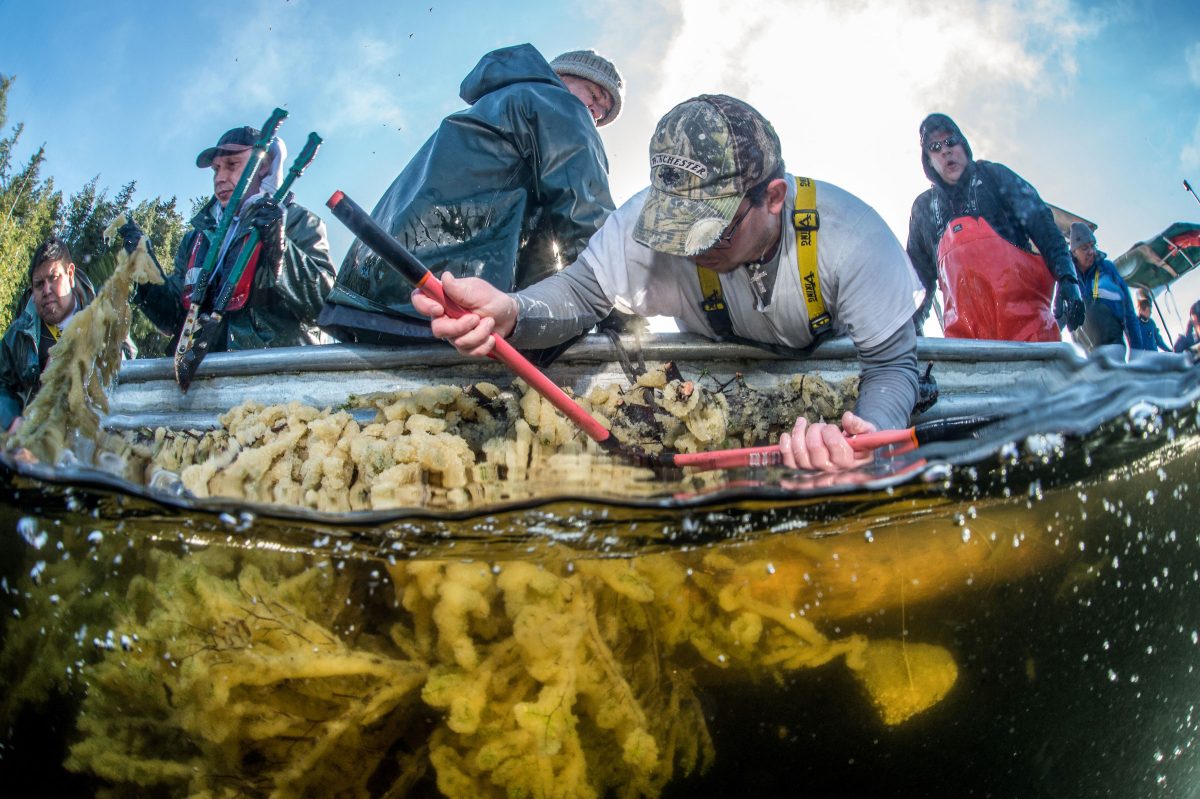
Heiltsuk First Nation fishermen harvest hemlock boughs coated in herring eggs for their community food fishery. Photo by Ian McAllister/Pacific Wild
The annual herring roe harvest constitutes a movable feast, which keeps everyone guessing when the herring will arrive and in what numbers. Preparations have been underway for weeks: boats bailed; engines tuned and tested; ropes, buoys, and tarps rounded up; licenses purchased and crews signed on; kelp and hemlock boughs harvested and transported to the herring grounds; lots of jostling for prime shoreline sites to set lines; and constant scans of the early reports from test boats and spotter planes searching for the first signs of herring. The excitement is palpable as winter storms give way to herring weather—a time when, according to Heiltsuk lore, the moon tips over because it is so full of herring. Their arrival in such vast numbers is so momentous, it marks what the Heiltsuk consider to be the start of their new year.
This year, the spawn coincides with another movable feast: Easter. On this Easter Sunday, the children’s chocolate egg hunt in the village of Bella Bella is as urgent as anywhere, but it is gladly dispensed with at an early hour by adults who make up the dozens of crews hurrying onto the water to harvest a very different kind of Easter egg.
All around the world it is Resurrection Day, including in the heart of the Great Bear Rainforest.
It’s also a time, decades in the making, when Housty-Jones and hundreds of her fellow Heiltsuk are wresting back control and management of their fishery and resurrecting ancient ways of harvesting that have supported one of North America’s oldest fishing cultures since time out of mind.
Bella Bella, population about 1,300, is a remote community on Canada’s rugged 27,200-kilometer Pacific coastline. It is situated on a famed marine highway, the Inside Passage, roughly halfway between Vancouver and the British Columbia-Alaska border. The village is accessible only by airplane, boat, or ferry.
Administratively, the colonizing governments call this place Bella Bella Indian Reserve No. 1 located on Campbell Island, and Heiltsuk traditional territory is considered part of the Central Coast Regional District, the Great Bear Rainforest North Timber Supply Area, and Fisheries Management Area 7–Pacific Region.
Wágḷísla, meaning river on the beach, is the Heiltsuk name for Bella Bella. In the Heiltsuk language, the names of tribes “reflect our cherished relationship to water,” says H̓áziɫba Saul Brown, an eloquent negotiator for his nation, self-described food sovereigntist, and springtime herring skipper.
This language, and the worldview it embodies, doesn’t much feature in the dry language of federal resource management plans—one reason Brown believes the Heiltsuk are continually at odds with resource management decisions made by other governments.
In fact, the Heiltsuk, and dozens of other tribes the length of the BC coast, have been warring with the colonizers of British Columbia in one form or another since contact. It was to unfetter access to abundant resources—forests, fish, wildlife, minerals—that colonial governments herded Canada’s Indigenous people onto tiny reserves, welfared them as wards of the state, ignored their hereditary governance systems, and stole their children in what Canada’s highest judge referred to in 2015 as attempted cultural genocide. British Columbia’s First Nations have a lengthy list of grievances that only lately have begun to be taken seriously by the governments of Canada and British Columbia.
On the coast, those grievances are rarely more deeply felt than when it comes to marine resources, most famously Pacific salmon, one of the most celebrated symbols of the West Coast. It’s a staple of Indigenous cultures and ceremonies, a critical source of food, the basis for extensive trade among nations, and access to it is the subject of bitter debates and plenty of court cases.
But as charismatic as salmon are, bodies of traditional ecological knowledge dating back thousands of years reveal that herring are just as, if not more, important to the Pacific coast marine ecosystem and to tribes ranging from Alaska through British Columbia to Washington State.
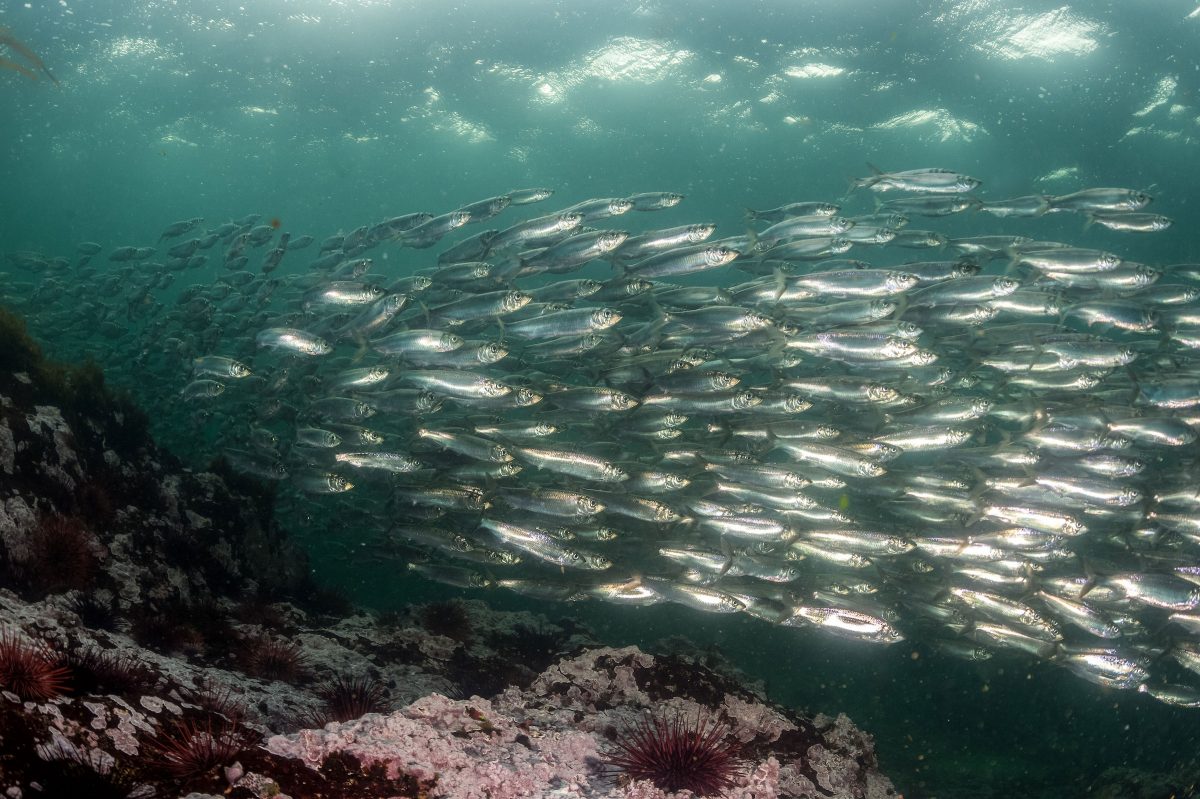
Each spring, schools of Pacific herring migrate to coastal British Columbia waters, where the fish and their eggs provide a huge pulse of nutrients to marine and coastal food webs. Photo by Ian McAllister/Pacific Wild
As forage fish, herring are vital fuel for marine food chains, nourishing everything from whales and sea lions to larger fish and seabirds. On the beach, their eggs feed wolves, bears, and birds, providing food and fertilizer to coastal ecosystems.
For their human predators, herring are valuable not just as food, as a source of omega-3-rich oil, as bait, and, of course, for their roe, but also because their arrival awakens other prey in a swirl of activity in the water, on land, and in the air—making hunting and fishing of other species easier both before and after the spawn. Traditionally, herring were also the first fresh fish to show up after long winters when people relied largely on dry goods. Then as now, says Wígvíɫba-Wákas Harvey Humchitt, “everything revolves around the herring.”
Humchitt is a hemas, a hereditary chief. Traditionally, the hemas and their right-hand men and women, auuks, oversaw the management of herring, guided by customary laws, teachings, and beliefs known as ǧvi̓ḷás.
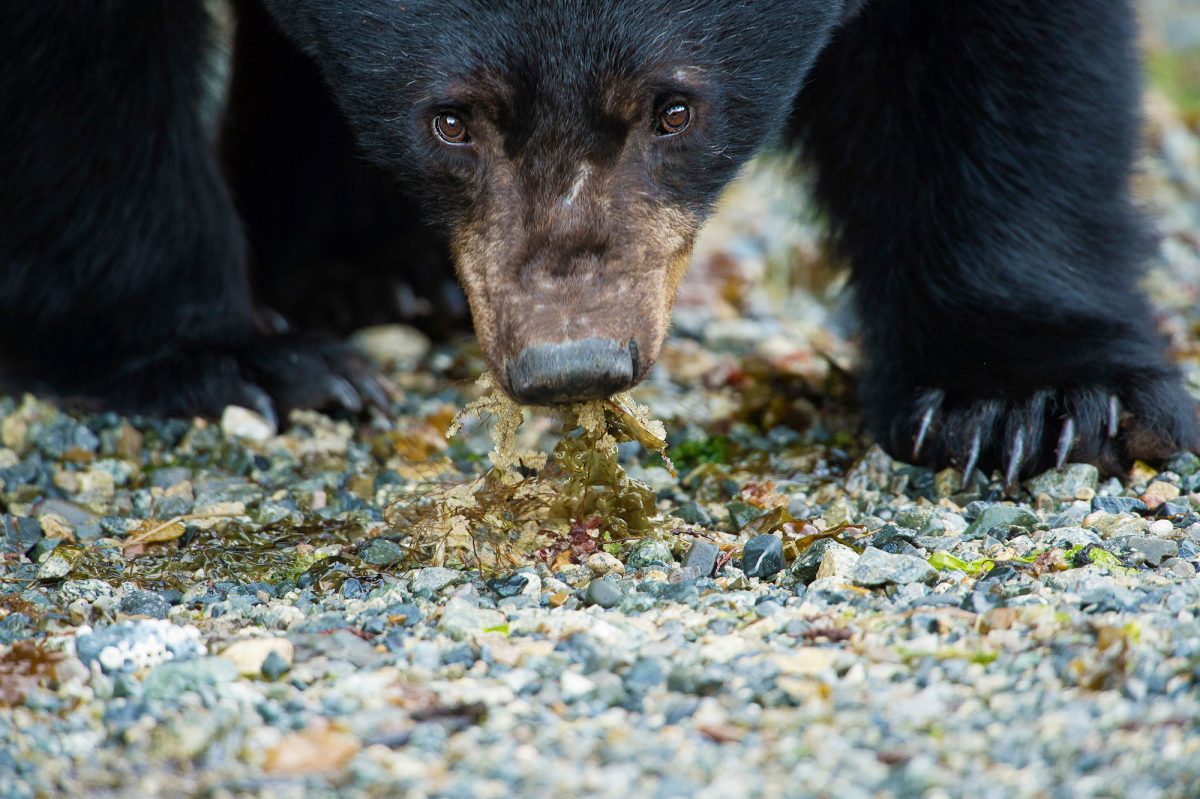
Herring eggs provide a much-needed spring boost of food to animals in the ocean and on land, including this black bear. Photo by Ian McAllister/Pacific Wild
So it was for thousands of years—until contact and the commencement, in the 1870s, of commercial fisheries, regulated under a fisheries act that robbed Indigenous people of their right to fish except for food, and even then under onerous restrictions, and ignored Indigenous management systems and fishing methods.
Non-Aboriginal fishermen got largely unfettered access to harvest herring, and harvest they did—especially with the advent of fleet mechanization and the introduction, in the 1930s, of a reduction fishery, which rendered herring into fishmeal or oil. By the 1960s, this huge “kill fishery” had taken billions of fish and pretty much wiped out stocks to the point that the entire fishery was closed in British Columbia between 1969 and 1972. Populations rebounded sufficiently, at least according to government and industry, to warrant reopening herring fishing in the 1970s.
Despite what were touted as improvements in stock assessment and fisheries management, the kill fishery remained just that. Fisheries and Oceans Canada (DFO) would announce openings, often of just a few hours, that mobilized massive industrial purse seiners and gill-netters to converge on prime areas like Spiller Channel. In stark contrast to the open-pond style of fishery practiced by the Heiltsuk—targeting just the roe, leaving the herring alive to spawn again several times during their lifespan—commercial sac roe openings are Wild West smash-and-grab affairs. Openings of short duration encouraged commercial skippers to scoop up tonnes of fish at a time and urgently reset their nets.
“As far as the eye could see, Spiller used to be lined with seine boats,” says veteran marine conservationist Ian McAllister of Pacific Wild. McAllister has lived and worked in the region for decades and says the seine fleet is “industrial mayhem” compared with the “quiet, elegant, simple fishery” that the Heiltsuk pursue. “Sea lions caught in their nets. Air banger explosives [to discourage the sea lions] making a huge noise under water. Some of the loudest sonars on the coast, industrial winches, the clanking of machinery—a cacophony of sound you can hear from miles away.”
The commercial fishery created “havoc on the water,” says Dúqva̓ísla William Housty, a respected Heiltsuk cultural leader and natural resources manager. “It’s just like a hurricane, this foreign thing that causes disruption to everything.” Not least the health of herring stocks themselves.
The commercial opening for herring is short, often just a few hours. Footage by Pacific Wild
Yet despite every indication of overkill, McAllister says, still the commercial fishery was reauthorized year after year. One study confirms that three of the five major herring populations in British Columbia declined over the last several decades that the commercial fishery was back in business. Industry’s insistence that DFO keep the fishery open triggered vehement opposition from many First Nations, and sometimes heated confrontations on the water—including in Spiller Channel in 2006, when Heiltsuk boats massed in protest against the seine fleet, paddling an oceangoing canoe into the middle of a purse net setting to disrupt it. One member was arrested as a result.
Eventually, DFO couldn’t ignore the obvious. The commercial fishery was closed in three areas where populations had declined: Haida Gwaii, an archipelago off the northern BC coast in 2005; on the west coast of Vancouver in 2006; and in Area 7, in Heiltsuk waters, in 2008. Even though they didn’t have to, the Heiltsuk voluntarily suspended their own herring harvest. For a while at least, herring were given a breather amid an uneasy standoff between the commercial fleet, DFO, and First Nations.
And then along came 2015.
“We paddled over, mostly women and children,” Saul Brown recalls of the day the Heiltsuk took the matter of their herring fishery into their own hands.
“We made a decision to protect our rights,” says Núkva Kelly Brown, a long-time natural resources planner and negotiator for the Heiltsuk and, today, director of the Heiltsuk Integrated Resource Management Department (HIRMD). “To do that you have to go 100 percent all in.”
In late March 2015, the Heiltsuk and DFO, whose local office is on Denny Island, a short hop by boat from Bella Bella, were at an impasse about whether or not a commercial fishery should be authorized by the department. The Heiltsuk were implacably opposed to lifting the eight-year moratorium on the fishery.
They were well within their rights to stand fast against a commercial opening. Back in 1996, two Heiltsuk men, Donald and William Gladstone, won a landmark decision at the Supreme Court of Canada that affirmed that the Heiltsuk had practiced a commercial fishery—selling to each other and trading with other tribes—since before European contact and still had a right to do so. The court had earlier—in the 1990 Sparrow decision—set out a doctrine of priority that put conservation of stocks as a first priority; followed by an Aboriginal right to food, social, and ceremonial fish; then an Aboriginal commercial fishery; and only then—and only if herring stocks were healthy enough to allow it—a non-Aboriginal fishery.
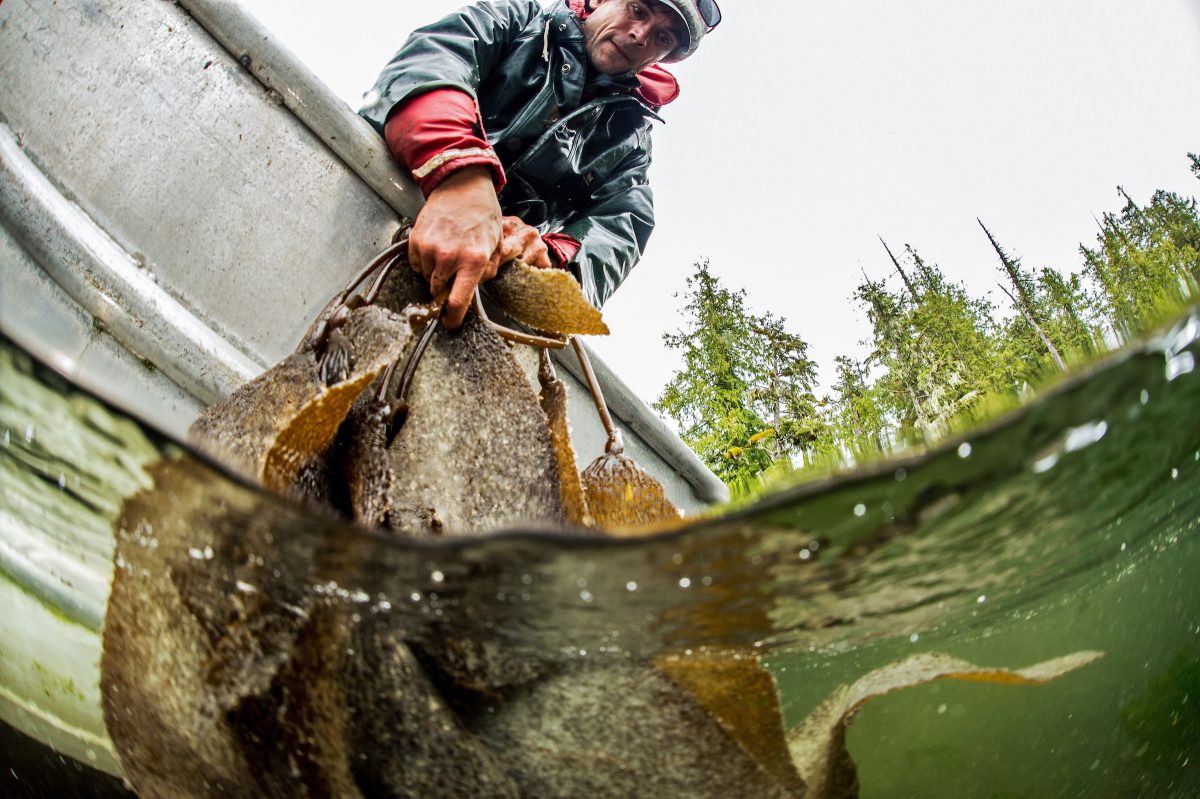
Fronds of q̓áq̓ḷ̓ís, or giant kelp, are hung to gather herring roe for the commercial harvest. Eggs adhere to both sides of the kelp and are traded locally and exported to Japan. Photo by Ian McAllister/Pacific Wild
Yet almost two decades after the Gladstone case, DFO’s decision-making in the field still seemed guided by the demands of industry. In practice, the Gladstone ruling didn’t confer any real authority on the Heiltsuk, and there was growing frustration that what little consultation did happen was just a bureaucratic merry-go-round. So, in 2015, when word reached the community that commercial seine boats had been fishing up in Spiller, surreptitiously authorized to do so by DFO, that doctrine of priority suddenly looked a lot like a doctrine of deceit.
William Housty says DFO’s actions “were just so wrong.” Besides not informing the Heiltsuk they’d approved a fishery, DFO also allowed fish from a test set—fish that normally should be released—to be sent for commercial sale. As well, they signaled to gill net fishermen that a commercial opening in Spiller Channel would be forthcoming. All this, after the Heiltsuk had shared with DFO their forecast that the size of returning herring stocks did not justify any industrial-scale fishery.
Brown’s father, Yím̓ás ⅄áλíy̓asila Frank Brown, and a few community members went over to Denny Island, where they put fisheries officers on notice that as far as the Heiltsuk were concerned, the fishery was closed. That message was reinforced with a traditional Heiltsuk song and drumming. Meanwhile, at a meeting in the United Church in Bella Bella, members of the Heiltsuk Tribal Council agreed with a council of hemas to sign off on an eviction notice to be served on DFO.
The next day, Saul Brown led a canoe party over to Denny Island. Other band members took a water taxi. About 50 or 60 Heiltsuk rallied outside the office and eventually someone pinned a notice to the doorjamb that read: “Due to Lack of Respect for Heiltsuk Gvilas You are Hereby Given A Notice of Eviction from the Heiltsuk Nation.”
Saul Brown recalls that after they served DFO the eviction notice, his fellow Heiltsuk started to leave. “This is bullshit,” he said to them. “Why are we leaving?” A number of band members then occupied the coast guard office downstairs. When Kelly Brown and the elected chief of the Heiltsuk First Nation, Ǧáǧvi Marilyn Slett, arrived from the village to reinforce demands to shut the proposed gill net fishery, they were allowed into the DFO office, but the protesters were not. So Brown and Slett locked down the office with themselves and several DFO officers inside and refused to leave.
In fact, they stayed there four days.
During the 2015 occupation of the Fisheries and Oceans Canada (DFO) office, Heiltsuk elders and negotiators meet with Sue Farlinger, DFO’s regional director general. Footage by Pacific Wild
Word of the occupation reached Vancouver, 500 kilometers to the south, and caught the attention of big-city media. Up on Denny Island, the Heiltsuk dug in. The building was surrounded around the clock by band members offering food, security, and moral support to their leaders. They also brought songs, in particular a song that had been written just weeks earlier about herring’s role in “the vitality of our culture,” Saul Brown said. It wasn’t intended as a protest song, but it instantly became “an anthem for what we were doing. Singing that herring song, it was medicine at the time.”
When the occupation ended, DFO had capitulated. While its official coast-wide summary of the 2015 herring fishery records a gill net opening from noon until 8:00 p.m. on March 31, not a single herring was caught in Area 7. “Number of licences: 60. Quota: 600 tons. Catch: 0,” the summary says.
Slett was jubilant. “We did it! [Spiller] was our no-go zone, and nobody went there.”
Perhaps even more significant in the long run was DFO’s promise to forthwith manage the herring fishery in Area 7 jointly with the Heiltsuk, formally incorporating Heiltsuk knowledge and priorities into stock forecasts and management plans for the first time. That means having Heiltsuk observers on test boats. It means having Heiltsuk scientists on technical committees and Heiltsuk hemas providing advice on every aspect of the fishery. And it means joint sign-off on any decision to fish.
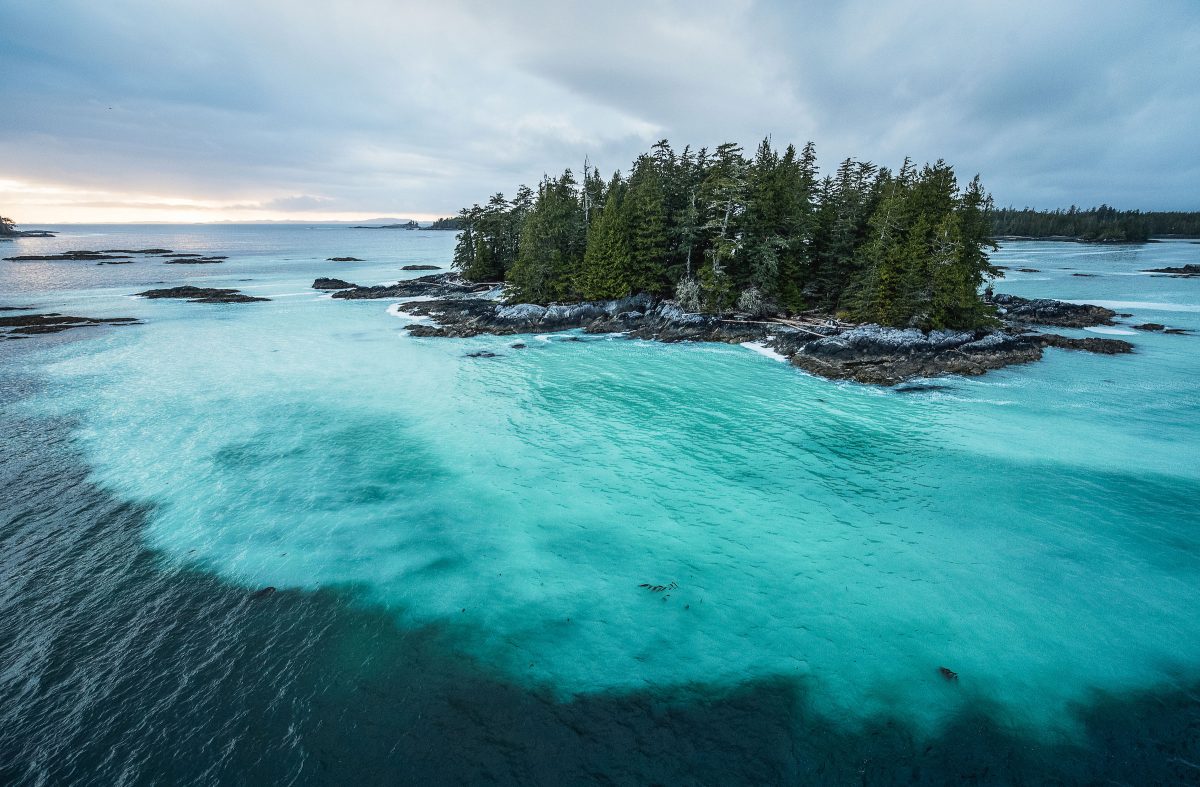
Milky green or turquoise coastal water such as this is a sure sign that male herring have spawned. Photo by Ian McAllister/Pacific Wild
The agreement has teeth. In 2016, the first season after the occupation of the DFO office, the harvest rate was lowered from 10 to seven percent of available stocks and there was a full closure of the sac roe fishery in Spiller Channel. In all, just 239 tonnes of herring were harvested on the central coast by seiners that year. The Heiltsuk, meanwhile, were allocated 109 tonnes of commercial roe on kelp (usually referred to as spawn on kelp [SOK] in regulations).
In 2017, the seine quota was set at 219 tonnes, but by agreement between DFO and the Heiltsuk, the commercial fishery never opened. Again, the Heiltsuk SOK quota was 109 tonnes that year.
This year, the commercial fleet was lobbying hard for permission to again drop its nets in Spiller, pushing for about 600 to 800 tonnes.
But the Heiltsuk’s interpretation of the data they had collected with DFO was that the stocks still were too weak for that.
“This year, there was a lot of pressure from our guys to say no,” says Kelly Brown. “Everybody said no, there’s not enough herring, so no sac roe fishery.”
That’s what they told DFO this past February. On March 1, DFO announced it had agreed to suspend the commercial roe herring fishery on the central coast for 2018 after the Heiltsuk and DFO had been “unable to reach a shared understanding of stock health” that would allow both a commercial and a Heiltsuk SOK fishery to proceed. The Heiltsuk’s SOK quota was actually increased to more than 136 tonnes. The commercial fishery was shut down completely.
That “absolutely did not go down well” with industry, says Colin Masson, north coast area director for DFO. Masson concedes that negotiating management agreements with First Nations and only then putting them out for wider review is a “fundamentally different approach [that] doesn’t just open the door for industry like it used to in the past.” Housty says previous practice was that DFO and industry would negotiate management plans behind closed doors, and not until an Integrated Fisheries Management Plan was made public would First Nations get to see the plan and raise any objections.
Masson says industry was shocked in 2015 when DFO agreed to its joint management approach with the Heiltsuk and to this day does not support it. Even inside the department, he says, “there are some people saying it’s gone too far. The DFO-Heiltsuk agreement is at the outer extent of how far we can go without compromising ministerial authority. I’m not sure the Heiltsuk appreciate how far this agreement has gone.”
Kelly Brown certainly seems to.
“It’s the first time they’ve ever done that for any fishery anywhere,” Brown says, “No commercial fishery, not even a token one.”
When herring spawn, their sticky eggs fill the water and cling to any and all available surfaces. Footage by Grant Callegari
How radical is that? When the federal Liberals came into power in 2015, they did so on a promise to honor the United Nations Declaration on the Rights of Indigenous Peoples, with its requirement to seek Indigenous people’s free, prior, and informed consent over resource decisions affecting them. The government seems impossibly conflicted about how to do that in practice, especially when it comes to big-ticket items like pipelines and hydroelectric dams. When it comes to the central coast herring fishery, you have a First Nation that worked within a government-sanctioned collaborative process, insisted that their joint modeling did not satisfy the community that stocks could withstand a commercial fishery, told the government it did not have Indigenous consent to authorize an opening, and the government listened and acted accordingly.
And then Easter rolled around, and the herring rolled into town, and the Heiltsuk—and only the Heiltsuk—went fishing for herring roe in Heiltsuk waters.
Easter Monday. Louisa Housty-Jones and Ian Wilson are headed for Spiller Channel again. William Housty joins them in the skiff. Anticipation is high. On Sunday afternoon, the spawn in Spiller had been happening “hard and fast,” in Ian McAllister’s words.
The herring are flooding into inlets and bays and lagoons, the females carpeting the shore with billions of tiny eggs, the male milt turning otherwise dark waters a milky pale green, the color of limetta gelato.
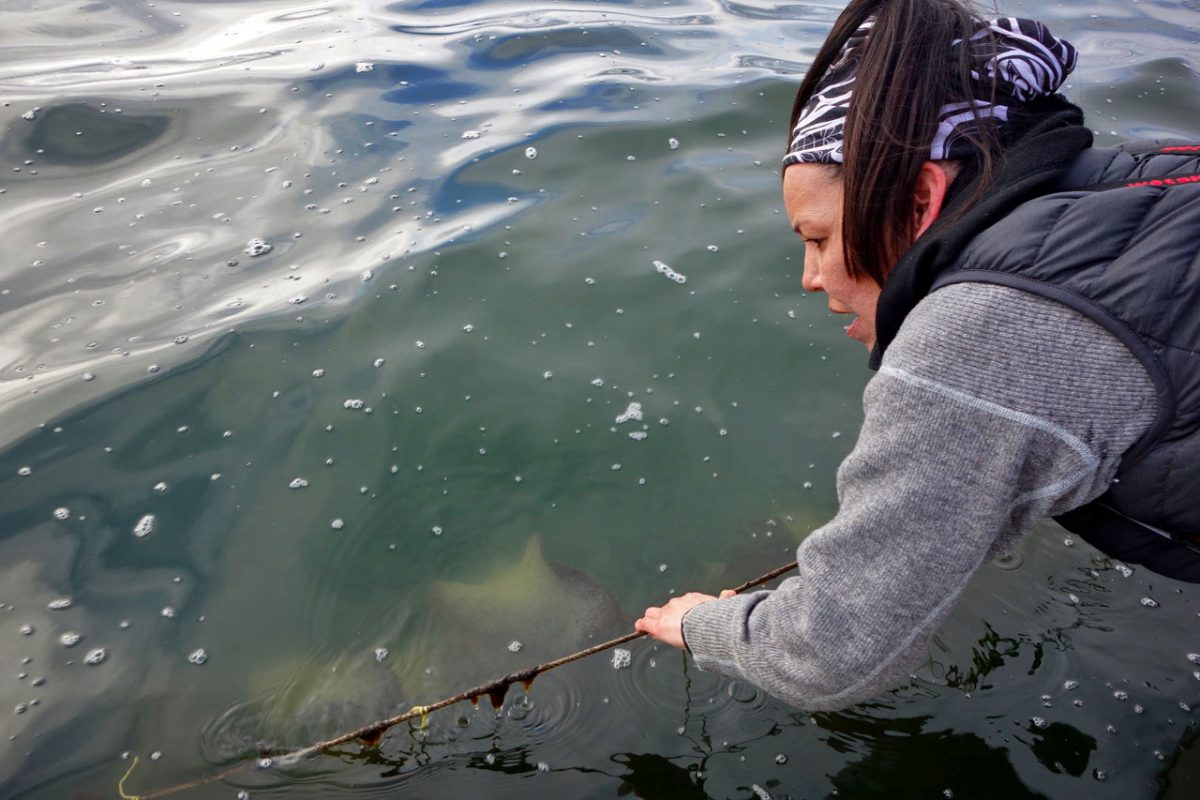
Louisa Housty-Jones pulls up her lines that were set to intercept herring eggs with hemlock branches and strands of kelp. Photo by Ian Gill
With the herring have come all manner of other creatures looking for a feed. From McAllister’s catamaran, I watch a large humpback whale working the shallows. Sea otters, dozens of eagles, flocks of surf scoters, gulls, sea lions, seals, and porpoises all dine out. McAllister, who is shooting an IMAX film on the Great Bear Rainforest (featuring, among other scenes, Saul Brown harvesting herring roe), guts a ling cod he caught for dinner; in its stomach, a good-sized herring.
I later hop into Housty-Jones’s punt to help with the harvest. She draws alongside a floating log that secures her network of hemlock boughs and kelp. All of us strain to see how big a share they’ve snagged. The punt tilts precipitously to port as all hands reach eagerly into the water. A tree bough is visible below, its fronds not green but a creamy pale-brown, almost beige color. A cord is cut and the heavily laden bough is dragged alongside the skiff. Individual branches and fronds, weighted thickly with roe, are snipped off the main stem, dipped in the salt chuck and shaken, and then swung over the gunwale into a large hold lined with tarps.
“Why do you dip the eggs in the water?” I innocently ask.
“To get the cum off,” Housty says.
“Well, that’s straight and to the point,” Housty-Jones says with a laugh.
It takes about an hour to fill two of the punt’s four open holds with roe on hemlock fronds. Totes the size of large picnic coolers occupy a third hold, and into them the crew places roe that’s been deposited on stringy, or feather boa, kelp (Egregia menziesii), which locals consider a delicacy. The Heiltsuk call it y̓ák̓a.
A more common giant kelp (Macrocystis pyrifera)—what the Heiltsuk call q̓áq̓ḷ̓ís—hangs below the water’s surface on Housty-Jones’s commercial sets, its long flat blades like vertical blinds in an office building. Roe accumulates on either side of the kelp, the more layers the better. The product will be graded for export as 1, 2, 3, J, or JJ, which on the cross section can measure several centimeters thick, the kelp itself looking like a thin piece of veneer between two thick layers of particle board. Or like an ice cream sandwich, with the ice cream on the outside.
Along the British Columbia coast, First Nations harvest only the roe of herring, capturing the sticky eggs on kelp or hemlock branches. Footage by Grant Callegari
Housty-Jones and the crew return to shore and offload their haul into the back of a pickup lined with tarps. In keeping with the doctrine of priority, her first harvest goes to her family for food, social, and ceremonial purposes. A portion of the Heiltsuk’s harvests are routinely set aside to be traded locally and with other First Nations on the coast. Roe from their commercial sets is sent to the Heiltsuk-owned and operated fish plant in Bella Bella and then to market. The main export market for herring roe is Japan, where it is called kazunoko and is much sought after.
At the Brown household that evening, dinner consists of roe on both stringy and flat kelp, elk meat from Vancouver Island, boiled potatoes, dried seaweed, and, for dipping, the rich, much-adored oil from the sardine-sized eulachon fish that spawns in just a few coastal BC rivers. (So stridently fishy does it taste, it’s like a wince-inducing marine version of Vegemite.)
Roe on kelp is rubbery to the touch, slightly sticky (depending on how thoroughly it was rinsed when it was harvested), and looks like miniature bubble wrap. It pops a bit like bubble wrap when you bite into it, too, tiny explosions of ocean—crunchy and salty. It is delicious, albeit a taste—like raw oysters, or eulachon grease, or salmon eyeballs—that takes some acquiring. Not everyone does.
For Saul Brown, the finest taste of all is roe on hemlock bough, called h̓a̓ṇ́t, because it combines flavors from the lands and waters that the Heiltsuk hold so dear. “It has a beautiful evergreen taste to it, and the egg itself tastes of the ocean,” he says. “It’s a culinary embodiment of the interconnectedness of the land and the ocean. There are not many things I’ve had that can give you that experience.”
Brown works as the Heiltsuk’s haíɫcístut negotiator, haíɫcístut being a potlatch term meaning “to turn things around and make it right again,” which is how the Heiltsuk choose to define what others call “reconciliation.” For Brown, indeed for all Heiltsuk, turning the tide on how herring are managed in their territory is just one of many steps toward actual, rather than merely rhetorical, decolonization.
With the roe fishery in full swing, William Housty is bullish on the ability of the Heiltsuk to convert their success with herring into a new management paradigm for other marine species.
Housty explains that as part of a reconciliation negotiation between the Heiltsuk and the federal government, the Heiltsuk have tabled their desire to manage all commercial fisheries in their traditional territory on their own terms.
“That’s our intent,” echoes Kelly Brown, “salmon and crab first, in the next 18 months, then geoduck, then shellfish, halibut.”
Colin Masson, of DFO, isn’t sure the Heiltsuk herring agreement will translate easily to other species. Through the Gladstone decision, the Heiltsuk have “a court established right to a significant portion of the herring fishery,” Masson says, but that doesn’t hold for, say, geoduck.
The herring agreement is a “completely different frame from how the department worked with First Nations before,” he says, and he’s hopeful that what will translate to other nations and other species is a collaborative process that “recognizes Aboriginal rights, but takes into account other Canadians’ priorities as well.”
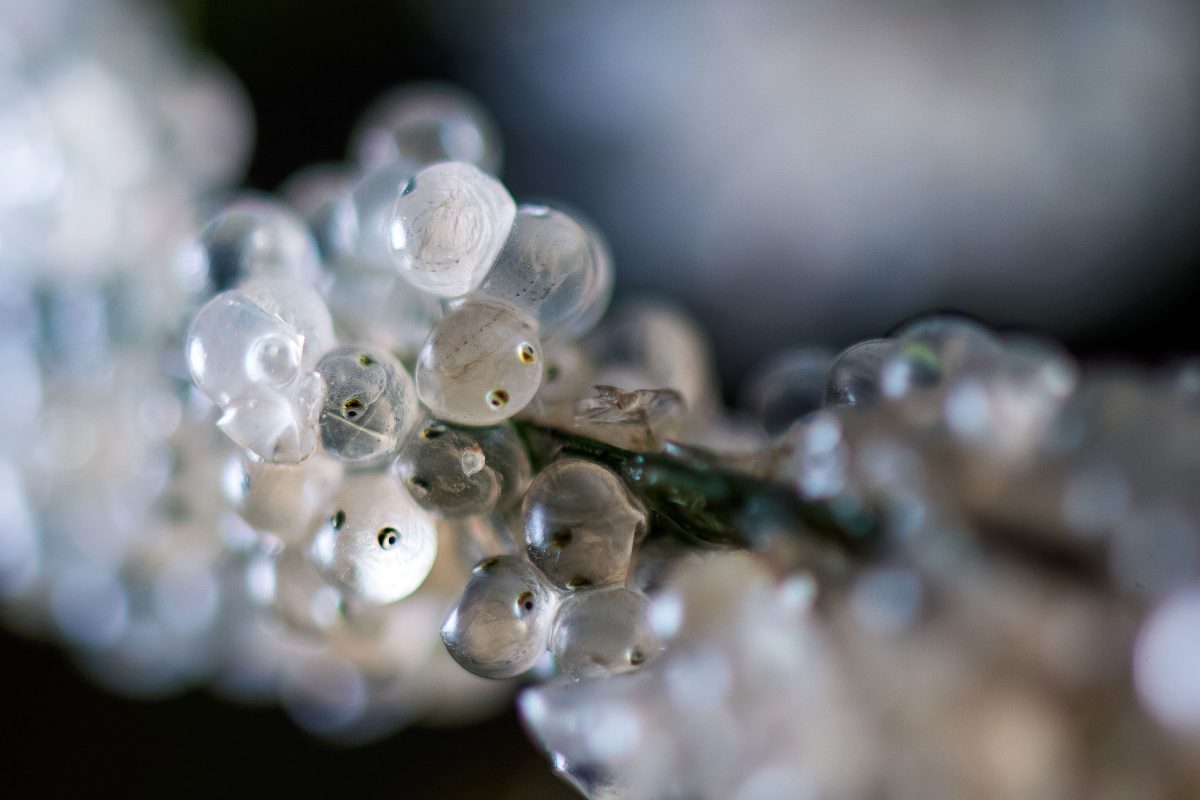
During the spring spawn, herring release swarms of sticky eggs. These fertilized eggs show the eyes of developing juveniles. Photo by Ian McAllister/Pacific Wild
Will that satisfy the Heiltsuk? This coming October, a first draft of a new Heiltsuk Constitution will be presented to band members. Housty says the first piece of Heiltsuk legislation planned to flow out of that will be an oceans act. Canada already has one of those to manage its oceans and fisheries; Canada already has a constitution, too. But to the Heiltsuk, neither seem to reflect their vision of how to prosper as a nation, and you can bet a punt full of y̓ák̓a that a constitution and an oceans act written by the Heiltsuk will read a lot differently from Canada’s—and no doubt will be called something different, too. Something more, well, Heiltsuk.
Whether or not Canada will recognize a Heiltsuk constitution is an argument the Heiltsuk are spoiling to have. “We’re making that movement to self-government, slowly but surely,” Housty says. And toward self-sufficiency. The HIRMD issued 740 licenses to harvest individual quotas of herring roe this year, a huge number when you consider that the official on-reserve population of Bella Bella is not even twice that number (although the population swells with band members returning for harvests, herring and salmon, in particular). Despite a big spawn in Spiller Channel, a lot of the returning herring were juveniles, which just spawn for a few hours, not a few days like adults do. So some people missed out. But even if just half the crews were successful, Housty says, that’s a huge infusion of otherwise scarce income for local people—mostly from sales of product to Japan.
As for Housty-Jones, she did okay in the end, partly because she finished setting her lines just a day before the spawn started. Everyone on her crew got their quota. “Our product was really good,” Housty-Jones says. “We got so much y̓ák̓a.” Her family’s freezers are full, and she put aside 20 buckets to share at a potlatch later this year. The crew met their commercial quotas, too, and actually ended up with four extra totes of product they were able to share with community members in need.
It was just last year, she recalls, that “Dad said, ‘Well, you passed the test,’ and I said, ‘What test?’ And he said, ‘All this gear is yours now.’” She’d proven to him that she had the right stuff to captain her own boat. “So that was huge,” she says. This year, once the Heiltsuk marketing team negotiated with the Japanese and the final price for her herring was set, Housty-Jones did well enough to pay for that new outboard motor and keep her gear in good shape for when the moon tips over again next spring.
The author would like to say ǧiáxsix̌a (thank you) to H̓áziɫba Saul Brown and Ǧvu̓í Rory Housty for their invaluable assistance with the Haíłzaqv language.


